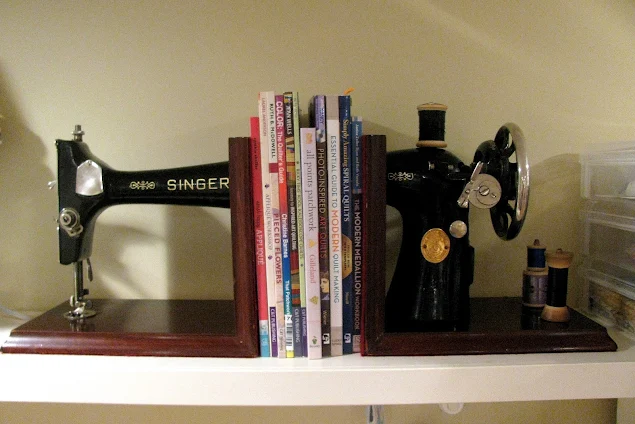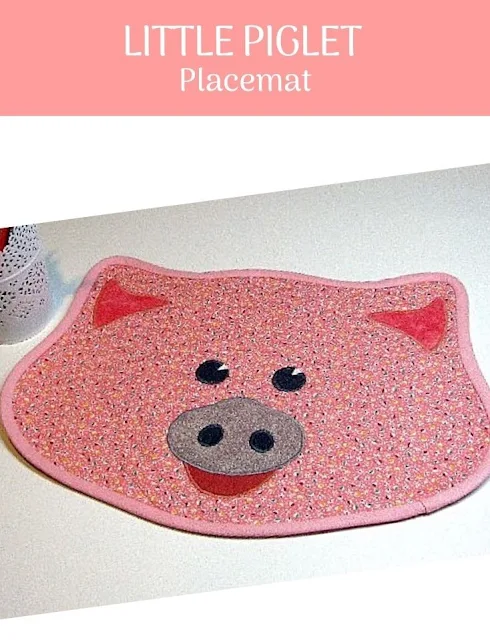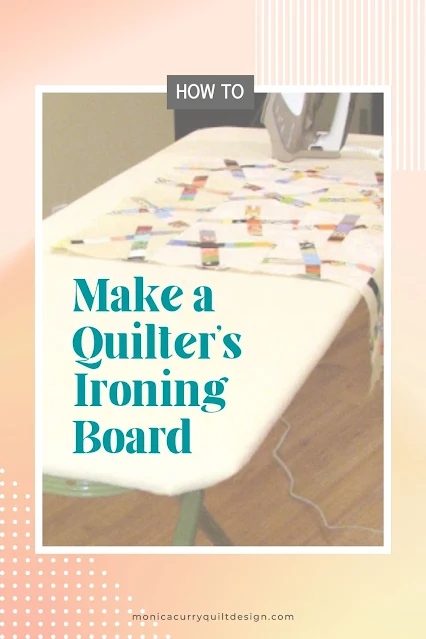This spring I'm launching two new placemat patterns, Baby Jersey and Little Piglet. Aren't they adorable? I'm sure your child or grandchild would love one of these to make mealtime fun. These placemats are easy to make using fusible appliqué and simple straight line quilting.
4 Must-Have Irons for Quilting
Three guidelines when buying an iron for quilting:
- Determine your needs. Do you quilt only occasionally or is your iron going to get a full workout? Do you do patchwork, applique or both?
- Do your homework. Research different products.
- Purchase the best iron you can realistically afford. There are many good irons at different price points, so shop around if you're on a strict budget like most of us.
1. Steamfast Mini Steam Iron
My Steamfast Mini Iron is my little workhorse. It sits beside me on my TV table ironing board when I'm doing all my piecing. It's the perfect size for paper foundation piecing and is great for pressing down seams and fused applique pieces. It heats up fast and stays hot.
2. Rowenta Focus II Iron
It's important to have a good basic iron for quilting. A top functioning iron is worth its weight in gold. My rule of thumb is to buy the best iron that you can afford. Top quality irons come at various price points. Also, you likely don't need all the bells and whistles for quilting so do your research. When I turned 60 last year, I treated myself to a brand new iron, a very sexy Rowenta Focus II. The German made Rowentas are considered the best steam irons on the market. It took me a while to decide on a new iron, but after some research, I settled on this one; I'm so glad I did. This iron is an absolute gem. I know the Oliso iron has been toted as the must-have iron for quilting, but the reviews for the Rowenta were better.UPDATE (January 15/22)
I'm sad to say that my Rowenta lasted only 6 years. It began to leak from the bottom. I truly loved that iron but it had to be replaced.
The Rowenta was replaced with the awesome Panasonic NI-WL600 Cordless. I've been using it for a couple of months and, although wary, I'm completely sold on it.
KEY FEATURES of the Panasonic NI-WL600 Cordless Iron
- CORDLESS, 1500W STEAM/DRY IRON End the hassle of twisted, tangled power cords for quicker, easier, more convenient ironing on a variety of fabrics.
- IRON IN EVERY DIRECTION Sleek, contoured 360° Freestyle soleplate has a double-tipped design to ensure natural movement in any direction. Iron effortlessly forward, backward and even side-to-side for precision and speed.
- ADJUSTABLE STEAM & DRY SETTINGS – Set to HIGH for heavier and everyday fabrics, LOW for more delicate fabrics and quick, easy touch-ups or choose DRY for easy ironing when no steam is needed.
- HEAT, STEAM AND DRY SETTINGS Apply the perfect level of heat and steam, or no steam with the touch of button; a powerful vertical steam feature quickly removes wrinkles on curtains and hanging garments.
- MAXIMUM PORTABILITY A matching lightweight, heat-resistant carrying case snaps easily onto the iron and power base after use for instant portability and storageFrom: Panasonic Website
3. Mini Iron
The Clover Mini Iron is a must have for doing fusible web applique, especially when pressing down small pieces or long appliqued stems. I like that the tip is small enough so I can see what I'm doing.
Mini Iron Stand
My only beef with this mini iron is that the stand you get with it is not great. I use an old plate to put the hot end on when I'm working but I'd highly recommend you get yourself a wooden stand like the one below. This stand would be easy to make if you have the tools but for $10.39 at Connecting Threads, it's not going to break the bank to buy one.
4. Petite Press Mini Iron
I bought the Petite Press Mini Iron not too long ago when I had a project with lots of applique work. It heats up well, has a digital temperature setting, attached rest, adjustable handle and the ironing tip is double the size of the Clover. Over time, I could see this mini iron taking the place of my Clover.
QUILTERS PRESSING ACCESSORIES
1. Tailor's Clapper
I don't have these pressing accessories, but I felt they were interesting enough to let you know about them. Click on the links to get more info on these products. Tailor's Clapper This wooden block is used to press down seams after they've been ironed.
2. Teflon Pressing Sheet
Teflon Pressing Sheet A heatproof Teflon sheet for applique that keeps sticky stuff off your iron. |
DISCLAIMER: This article is my own personal review of these products. I do not receive compensation in any form from the companies referred to in this post.
Sewing Machine Bookends: Cool quilting room décor


The set even came with some vintage wooden spools of thread. I would love to find more of these spools.

Improv Quilting: The modern scrap quilt
One of my favourite piecing techniques is Improv. I come from a fine arts and design background so I love to go off the beaten path. I enjoy the freedom Improv provides. I believe it's quilting for the soul. There are no real rules for Improv quilting. You are basically piecing scraps together in a free-form way. The results are stunning. The textures and all the combined colours can result in a true work of art.
My piece Summer Aspen below was submitted for a new wing at a local hospital. The theme for the submissions was trees. I chose the Aspen tree because I love how Aspen leaves rustle in the wind. Unfortunately, the piece wasn't chosen but I ended up with a very nice quilt for my home.


I liked how this quilt turned out and it hung in my office for a couple of years. I now enjoy it as a sewing machine cover.

My art quilt Closing Time below was shown at the Manitoba Crafts Council Exhibition 2013. The quilt was named after Leonard Cohen's song Closing Time. While I was making the quilt this line from the song kept coming up in my head, "and the men they dance on the polka-dots" because of the polka dot fabric I was using.

In 2017, Rayna published her new book Create Your Own Improv Quilt: Modern quilting with no rules and no rulers. I haven't bought it yet but from what I can tell her style has changed from her first book.
My piece Summer Aspen below was submitted for a new wing at a local hospital. The theme for the submissions was trees. I chose the Aspen tree because I love how Aspen leaves rustle in the wind. Unfortunately, the piece wasn't chosen but I ended up with a very nice quilt for my home.
 |
| SUMMER ASPEN by Monica Curry |
The strips I used for the tree trunks in Summer Aspen were cut from fabric that was printed from a linocut I made. I wanted each strip to look like an actual Aspen tree.


I liked how this quilt turned out and it hung in my office for a couple of years. I now enjoy it as a sewing machine cover.

My art quilt Closing Time below was shown at the Manitoba Crafts Council Exhibition 2013. The quilt was named after Leonard Cohen's song Closing Time. While I was making the quilt this line from the song kept coming up in my head, "and the men they dance on the polka-dots" because of the polka dot fabric I was using.
 |
| CLOSING TIME by Monica Curry |
 |
| CLOSING TIME (Detail) Photo by L. Norman |
Improv Quilting Books
Several years ago I bought Rayna Gillman's book Create Your Own Free-Form Quilts: A Stress-Free Journey to Original Design. I wanted to try something new and push the envelope a little. I also had a ton of little scraps I couldn't bear to throw out. The result was my improv quilt called Summer Aspen (shown above). I really enjoyed making this quilt. Gillman's book is very comprehensive and well written. She provides very good step-by-step directions for her "free-form" quilting technique.

See more great examples of Improv quilts at my Pinterest board.
How to Accurately Cut Fabric for Foundation Paper Piecing
I first saw this technique in Simply Amazing Spiral Quilts by RaNae Merrill. I modified it slightly by using freezer paper. It's a simple and foolproof method for cutting your FPP fabric pieces. This method is especially great for when you have multiples of the same block.
INSTRUCTIONS
- Foundation piecing template that has been mirrored.
- 8½" x 11" sheet of freezer paper
- Scissors
- Rotary cutter
- Quilting ruler
- Fabrics for your block
- Coloured pencils or markers to match your fabrics.
2. Colour each section of the template with the fabric colour you want to use for that section. If a section is a white or cream colour, you can make a symbol to represent that colour or leave it blank.
3. Cut out each freezer paper section into separate pieces and lay them on the corresponding fabric with the right side of the fabric facing up. Leave a generous space all the way around each section. Press lightly with a hot iron to get the freezer paper to stick. If you need multiples of the same section, you can place the freezer paper sections on 4 to 5 layers of fabric.
4. With your quilt ruler, cut ¾ inch allowance around each section.
DIY Quilter's Ironing Board

HOW TO MAKE A QUILTERS IRONING BOARD
I've used a regular ironing board for quilting my whole life. So, when I started seeing these wide ironing boards for quilting, I knew I had to have one. I wish I'd made one of these years ago because it truly makes a difference when ironing quilt tops. If you have an ironing board, you can make one of these quilting boards yourself in a day.
SUPPLIES
- Standard metal ironing board
- 20" x 55" - 3/8" or 1/2" plywood (No saw? Most hardware stores will cut this for you.)
- [8] screws
- [8] washers
- [1] 26" x 60" cotton duck fabric.
- [1] 24" x 60" insulated batting. (I used Insul-Brite® by Warm Company)
- [2] 24" x 60" 100% cotton quilt batting TOOLS
- Measuring Tape
- Pencil
- Screwdriver
- Handsaw
- Sandpaper
- Staple gun and staples shorter than the thickness of your board
1. Measure and mark 1½ inches from the corners of the board. (Fig.1).
3. Staple the fabric and batting layers evenly around the edge of the board in this order.
(Fig. 3)
(Fig. 3)
Layer 1: Quilt Batting
Layer 2: Insul-Brite® batting shiny side up
Layer 3: Dotton Duck
Layer 4: Removable cotton ironing board cover.

Figure 3

Figure 3 (Detail)
4. Place ironing board upside down onto the board top being sure it is lined up correctly.
Mark where each screw will go. (Fig. 4)
Mark where each screw will go. (Fig. 4)

Figure 4
5. Screw the screws with the washers through the holes in the mesh. (Fig 5)

Figure 5

Figure 5

My Easter Egg table runner featured at Connecting Threads
This is my second pattern to be kitted by Connecting Threads. It's my Easter Egg Table Topper. The Easter fabric Eggstraordinary by Connecting Threads was perfect for this project. Buy the kit at Connecting Threads. Buy the pattern HERE.
Tips for Sorting Your Fabric Scraps

Well, another new year has begun. All the Christmas decorations are put away, the turkey leftovers are eaten, and life has fallen back into a regular routine. This is the time of year that I like to tidy my studio and get it ready for the days ahead. It's also the perfect time to purge some of my scrap fabrics and get them ready for scrap quilts.
When I first started sorting scraps, I wasn't quite sure what to do with them. I now follow a few simple rules I learned along the way.
1. Have a scrap basket handy to throw unused cut-offs. I keep mine under my cutting table..
3. Cut scraps in various sized squares. I cut an assortment of squares for nine-patch blocks in the following sizes: 5", 2¾", and 2". See my post on how to do this How To Cut Scraps for 9-Patch Quilt Blocks
4. You'll be amazed at how fast your square supply grows. Keep your squares in a storage container.
5. Keep leftover fabric strips to use for string quilts. I this container from the dollar store.
5. Keep leftover fabric strips to use for string quilts. I this container from the dollar store.
Download the FREE PDF pattern CHECKER BOARD SCRAPPY MINI QUILT PATTERN
HERE ARE SOME EXCELLENT SOURCES THAT HELPED ME GET MY SCRAPS ORGANIZED
Subscribe to:
Posts (Atom)































